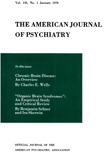A SURVEY OF SZONDI RESEARCH
Abstract
This review has been rather superficial in the interest of preserving the aim of the paper: to present a summary and integrated perspective of Szondi research. No review can be a substitute for a thorough examination of original sources. On the other hand, some general criticisms should be made of the design of these studies.
Without becoming picayunish about statistics it might be pointed out that most of the statistical techniques employed in the experiments reported are approximate only. This is a consequence of the lack of a meaningful scale in test results and the skewing of data that results from forcing preferences onto such a narrow scale. Chi-squares are to be recommended highly in the analysis of the sort of data relating to the factor loadings. The calculation of correlation coefficients in any fashion except through dichotomies will result in coefficients with little meaning.
Probably the criticism that fits all Szondi studies is that they are not crucial tests of the Szondi test itself. It hardly can escape the reader that all studies have nibbled on very small aspects of Szondi theory and application. No large-scale, sound validation attempt has come to the reviewer's attention. This would be the ultimate test of the pudding. It is well recognized that good validations are difficult because of the unreliability and invalidity of the criteria, as well as the difficulty encountered in transporting test results and criteria into a common language or frame-of-reference. This may account for the conspicuous absence of such studies. On the other hand, there has always been a certain scepticism about the value of this new test and investigators have gone slowly in their attacks on the problem before investing the time and money demanded by such a project as would be necessary to produce a convincing validation. This concentration upon smaller aspects of a system also indicates a methodological sophistication that is coming to the fore in all areas of research. The checking of deductive implications of postulates, as seen in the Szondi research, offers a convenient attack on problems that are inconvenient to handle in gross ways.
Certain value accrues to this piecemeal, deductive examination of the Szondi technique. Rather than rejecting the test completely, should validation attempts fail, it begins to seem possible to salvage the general technique. Through the study of the Szondi pictures much has been learned about the evaluation of personality through preferences for pictures. The factor analysis reviewed here revealed 5 independent factors from the consideration of 15 Szondi pictures. It seems likely that with new, carefully selected stimulus pictures presented in a well-designed forced-choice manner valuable information about a subject's personality can be obtained. When such information is treated in a multiple-correlation fashion with an empirically derived (factor analysis) frame-of-reference a valuable test of personality may become available.
Access content
To read the fulltext, please use one of the options below to sign in or purchase access.- Personal login
- Institutional Login
- Sign in via OpenAthens
- Register for access
-
Please login/register if you wish to pair your device and check access availability.
Not a subscriber?
PsychiatryOnline subscription options offer access to the DSM-5 library, books, journals, CME, and patient resources. This all-in-one virtual library provides psychiatrists and mental health professionals with key resources for diagnosis, treatment, research, and professional development.
Need more help? PsychiatryOnline Customer Service may be reached by emailing [email protected] or by calling 800-368-5777 (in the U.S.) or 703-907-7322 (outside the U.S.).



